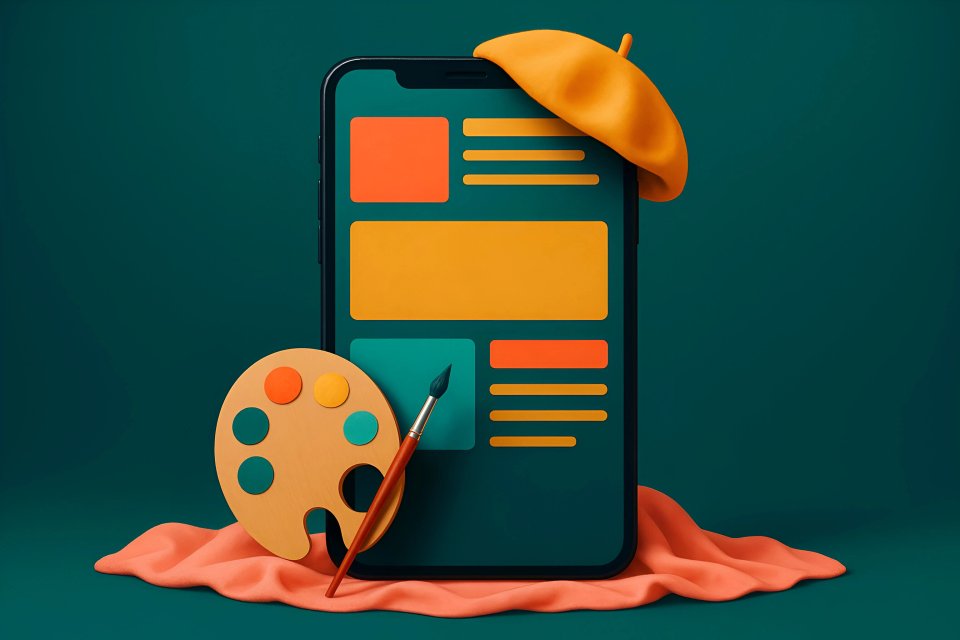Is your website just a pretty face, or is it a powerful extension of your brand's soul? In the digital battlefield, your website is often the first handshake, the first impression, the first chance to win hearts and minds. Shockingly, it takes about 50 milliseconds (0.05 seconds) for users to form an opinion about your website that determines whether they’ll stay or leave. If that first glance doesn't scream your brand, you're losing ground.
Many businesses pour heart and soul into crafting a compelling brand, only to see it crumble online. Their website feels… off. Disconnected. It fails to capture that unique spark, leaving visitors confused and prospects slipping through their fingers. This disconnect doesn't just look unprofessional; it actively sabotages your efforts to build trust and secure loyalty.
But what if you could change that? What if your website became a magnetic force, perfectly mirroring your brand's essence and drawing customers in? This guide is your roadmap. We'll walk you through, step-by-step, how to seamlessly weave your brand identity into the very fabric of your website design. The prize? A powerful, memorable online presence that not only looks incredible but also builds unwavering trust, skyrockets recognition, and smashes your business goals. With over 15 years of experience in captivating design and strategic marketing, we at CaptivateClick have seen firsthand how this integration transforms businesses from overlooked to unforgettable.
What is Brand Identity (And Why It’s More Than Just a Logo)?
Think your logo is your brand identity? Think again. That's like saying your signature is your entire personality. Your brand identity is the total package – the complete collection of elements a company crafts to project the exact right image, the irresistible allure, to its ideal customer. It’s the gut feeling people have about you.
So, what makes up this powerful force? It’s a rich tapestry woven from several crucial threads:
- Mission, Vision, and Values: These are the bedrock, the "why" that fuels your every action. They are the promises you make and the hill you're willing to die on.
- Brand Personality & Voice: Is your brand a wise mentor, a witty friend, or a fearless innovator? How it "speaks" and "behaves" defines its character and connects on an emotional level.
- Target Audience: Who are you desperately trying to reach? Knowing their deepest desires, fears, and aspirations is key to crafting an identity that resonates.
- Unique Selling Proposition (USP): In a sea of sameness, what makes you the undeniable choice? This is your secret weapon, your distinct advantage.
- Visual Elements: Yes, the logo is part of it, but so is your color palette, typography, and imagery style. These are the visual cues that trigger instant recognition and emotion, as highlighted by experts at The Branding Journal who describe brand identity as the unique characteristics influencing a brand's perceived personality.
A strong, clearly defined brand identity isn't just a "nice-to-have"; it's the absolute foundation upon which all your marketing triumphs are built, especially your website. According to Hinge Marketing, this identity is the visual and verbal expression of your brand, and getting it right is paramount. At CaptivateClick, our Brand Strategy and Visual Identity services are designed to help you unearth and polish these foundational gems, ensuring your website starts on solid gold.
The Step-by-Step Guide to Integrating Brand Identity with Website Design
Ready to transform your website from a simple online brochure into a brand-building powerhouse? It’s time to roll up your sleeves. This isn't about slapping your logo on a template; it's about a deep, strategic fusion that makes your brand unforgettable.
Step 1: Solidify Your Brand Guidelines
Before you even think about website pixels, you need a rock-solid rulebook: your brand guidelines. Don't have one? Stop everything and create it. Have one? Dust it off, scrutinize it, and ensure it’s comprehensive enough to guide your digital destiny. This document is your North Star for creating a cohesive brand identity with strategic website design.
What absolutely must be in these guidelines for seamless website integration?
- Logo Usage: Clear rules on variations (color, black & white, reversed), minimum sizes, required clear space, and, crucially, the "don'ts" – how not to abuse your most precious visual asset. Adobe, for instance, provides strict guidelines for their logo usage to maintain brand integrity.
- Color Palette: Your primary, secondary, and accent colors, complete with their HEX codes (
#RRGGBB), CMYK, and Pantone values. Define how these colors should be used to evoke specific emotions and guide user actions. - Typography: Specify your fonts for headings (H1, H2, H3, etc.), body text, calls-to-action (CTAs), and any other text elements. Detail the hierarchy, weights, and sizes to ensure consistency and readability.
- Imagery and Iconography Style: Define the mood, subject matter, and style of photography, illustrations, and icons. Should they be bright and optimistic, or dark and edgy? Human-centric or product-focused?
- Tone of Voice and Messaging Pillars: How does your brand speak? Is it authoritative, friendly, witty, or inspirational? Outline key messages that reinforce your USP and values. Developing comprehensive brand guidelines is crucial for this consistency.
These guidelines aren't just suggestions; they are the law of your brand. Businesses that maintain brand consistency can see a revenue increase of up to 33%, proving that clear rules pay off. CaptivateClick’s expertise in crafting detailed Brand Guidelines ensures every aspect of your brand is defined, ready to be translated online with precision.
Step 2: Translating Visual Identity to Your Website's Look & Feel
Now, let's bring that brand identity to life online, making your website visually irresistible. This is where your brand guidelines transform into tangible design elements that captivate and communicate. It's about more than just looking good; it's about looking right for your brand, leveraging essential website design principles to enhance your brand's identity.
Your logo deserves a prime spot, typically in the header, instantly orienting visitors. But don't let it overpower the content; it should be a confident signature, not a shouting billboard. Ensure it’s also present in the footer for consistent branding. Strategic color use is paramount; your brand colors should evoke the desired emotions and guide the user's eye, especially for CTAs and links, making them pop. Remember, color psychology plays a significant role in website design, influencing perception and action.
Typography is your brand’s voice made visible. Consistent font usage, reflecting your brand's personality (modern, traditional, playful), is key, but never at the expense of readability across all devices. As Rubber Duckers' work shows, the right typography can significantly shape your website's identity. Finally, your imagery and videography must be high-quality, on-brand, and resonate deeply with your target audience. Are you using authentic photos of your team, or aspirational lifestyle shots? Every visual choice reinforces (or dilutes) your brand message. In fact, 94% of first impressions relate to web design, making your visual choices critical. CaptivateClick’s UI/UX Design, Logo Design, and Visual Identity services ensure these elements work in perfect harmony, creating a visually stunning and brand-aligned experience. You can also explore modern web design trends for a strong brand identity to see how current styles can be leveraged.
Step 3: Aligning Website Content & Messaging with Brand Voice
Your website's words are just as crucial as its visuals. If your design screams "innovative tech leader" but your copy mumbles "we sell stuff," you've got a serious disconnect. Achieving true brand consistency online means every word, from headlines to button text, must sing in your brand's unique voice.
Is your brand voice professional and authoritative, or casual and witty? Whatever it is, ensure it’s consistently applied across all website copy – headlines, body text, CTAs, microcopy (like form field hints), and even error messages. A brand voice template can help define and maintain this consistency, ensuring everyone on your team speaks the same language. This consistency is vital, as branding in content design builds trust and familiarity.
Beyond just the tone, your core messaging – your USP, mission, and values – must be expertly woven into the narrative of your website. Your "About Us" page isn't just a history lesson; it's a prime opportunity for brand storytelling through website design. Tell your story, share your passion, and make an emotional connection that turns visitors into loyal advocates. Using a content style guide, as suggested by UX Writing Hub, can ensure clarity and consistency in your terminology and messaging.
Step 4: Ensuring UI/UX Design Reflects Brand Personality & Values
User Interface (UI) and User Experience (UX) design are not just about making things easy to use; they are powerful channels for expressing your brand's personality and values. A clunky, confusing website screams "we don't care about you," no matter how beautiful your logo is. Conversely, an intuitive, delightful experience reinforces positive brand perceptions. Combining user experience and branding in website design is key to this.
Consider your navigation and site structure. A brand built on simplicity and efficiency should have a streamlined, intuitive navigation. A luxury brand, as noted by Ironhack, might use more white space and a more deliberate, perhaps even unconventional, navigation to convey exclusivity and sophistication. The layout and use of white space dramatically impact the feel – spacious and airy for elegance, or dense and vibrant for energy.
Interactive elements and animations, when used thoughtfully, can inject personality. Subtle hover effects, smooth page transitions, or engaging micro-interactions can delight users and make your brand more memorable – if they align with your brand's character. Crucially, designing for accessibility isn't just a best practice; it's a statement of your brand's values, reflecting inclusivity and care for all users. As Nielsen Norman Group points out, brand experience is deeply intertwined with UX, and a positive UX can be a significant brand differentiator. CaptivateClick’s UI/UX Design services focus on creating experiences that are not only user-friendly but also deeply resonant with your brand, which naturally leads to better Conversion Optimization.
Step 5: Technical Considerations for Brand Reinforcement
Behind every great brand experience online lies a technically sound website. You can have the most stunning design and compelling copy, but if your site is slow, insecure, or broken on mobile, your brand image takes a massive hit. These technical aspects are silent but powerful communicators of your professionalism and respect for the user's time.
Website performance and speed are non-negotiable. A slow-loading site screams inefficiency and can frustrate users into leaving before they even see your brilliant branding. Google emphasizes frontend performance for content-driven sites, and studies consistently show that faster sites lead to better engagement and conversions. Investing in best technical optimization practices for fast websites is investing in your brand's reputation.
Mobile responsiveness is equally critical. With a significant portion of web traffic coming from mobile devices, your website must provide a seamless experience on every screen size. If users have to pinch and zoom, they'll bounce – and your brand will look outdated. Finally, security is paramount for building trust. A secure website (HTTPS) signals that you care about your users' data. SSLTrust highlights that security is a key factor in user trust and repeat visits. CaptivateClick’s Performance Optimization, Security & Updates, and Web Development services ensure your website’s technical foundation is solid, reinforcing a brand image of reliability and professionalism.
Step 6: Pre-Launch Review & Testing for Cohesion
You’re almost there! Before you unleash your newly brand-aligned website upon the world, a thorough review and testing phase is absolutely critical. This is your last chance to catch any inconsistencies or issues that could undermine all your hard work. Don't skip this step; it’s like a final dress rehearsal before the main performance.
First, conduct a meticulous internal review. Go through every page, every link, every image, and every piece of text, checking it against your brand guidelines. Does the logo appear correctly everywhere? Are the brand colors used consistently and appropriately? Is the typography as specified? Is the tone of voice consistent? This internal check ensures everything aligns with the blueprint. According to Crocoblock, a pre-launch website testing checklist should cover functionality, performance, and design consistency.
Next, consider user testing, even if it's informal. Get fresh eyes on the site – people who haven't been involved in the design process. Ask them: Does this website feel like [Your Brand Name]? Is it easy to understand what we do and what makes us different? Is it easy to navigate and find information? Their feedback can be invaluable in uncovering blind spots. Finally, rigorous cross-browser and device testing is essential to ensure your website looks and functions flawlessly for everyone, regardless of how they access it. This diligence prevents a frustrating user experience that could tarnish your brand.
Maintaining Brand Consistency Online Post-Launch
Think the work is done once your perfectly branded website goes live? Think again. Launch day is just the beginning of a beautiful, ongoing relationship between your brand and your audience. Maintaining that hard-won brand consistency online requires vigilance and commitment, ensuring your digital presence remains a powerful asset.
Every new piece of content – blog posts, service pages, product descriptions, visuals – must strictly adhere to your established brand guidelines. This isn't the time to get creatively rogue. Consistency builds recognition and trust over time. It's wise to conduct periodic audits of your website, perhaps quarterly or bi-annually, to ensure it remains perfectly aligned with your brand identity, especially as your brand itself may evolve. Project AEON suggests an 8-point brand consistency checklist to keep things on track.
Crucially, ensure everyone on your team who creates or publishes content for the website is thoroughly trained on the brand guidelines. They need to understand the "why" behind the rules, not just the "what." Finally, listen intently to user feedback. How are users perceiving your website and, by extension, your brand? This feedback is gold, offering insights into how well your digital branding strategies are resonating and where adjustments might be needed. CaptivateClick’s Hosting & Maintenance services can help keep your site running smoothly, allowing you to focus on these crucial ongoing branding efforts. Remember, consistent branding can increase revenue by up to 23%, making this ongoing effort well worth it.
The Benefits of Successfully Integrating Brand Identity with Website Design
Why go through all this effort? Because the rewards are immense. When your brand identity and website design are perfectly synchronized, you unlock a cascade of benefits that propel your business forward, transforming casual visitors into loyal fans and boosting your bottom line. This isn't just about aesthetics; it's about strategic power.
First and foremost, you'll see a dramatic increase in brand recognition and recall. A consistent look, feel, and voice across your website makes your brand instantly identifiable and memorable in a crowded marketplace. This leads directly to enhanced user trust and credibility. A professional, cohesive website signals that you're a serious, reliable business that pays attention to detail, making people feel more confident engaging with you. Fuel for Brands notes that strong branding builds significant value and trust.
A well-integrated site naturally delivers an improved user experience and engagement. When the design intuitively guides users and the content speaks their language, they're more likely to stay longer, explore deeper, and interact more meaningfully. This clarity also ensures clearer communication of your unique value proposition. Your USP and core brand messages are effectively conveyed, leaving no doubt about why you're the best choice. Ultimately, all of this culminates in higher conversion rates – because trust, clarity, and a positive experience naturally lead to more desired actions, whether it's signing up for a newsletter, requesting a quote, or making a purchase. And the long-term prize? Stronger customer loyalty, as a positive and consistent brand experience fosters a deep connection that keeps customers coming back. CaptivateClick’s focus on Conversion Optimization is built on this very principle: a well-branded, user-centric website is a high-converting website.
Case Study Snippet: LexEnergy's Transformation
Let's look at a real-world example of this power in action. For instance, when CaptivateClick had the opportunity to redesign the LexEnergy website, a primary objective was to deeply integrate their refreshed brand identity, which centered on innovation and sustainability. This wasn't just a facelift; it was a strategic realignment of their digital presence.
The transformation involved implementing a new, vibrant color palette that spoke of energy and forward-thinking. We introduced modern, clean typography that conveyed sophistication and clarity. Crucially, the imagery and visual language were carefully curated to showcase their commitment to cutting-edge, sustainable solutions.
The result? The new LexEnergy website didn't just look better; it felt like the innovative leader they are. This cohesive brand presentation led to a marked increase in user engagement metrics and, most importantly, a much clearer and stronger brand positioning in the competitive energy sector. It’s a testament to how strategic brand integration can yield tangible business outcomes.
Conclusion: Your Brand, Magnified Online
Integrating your brand identity with your website design isn't just a checkbox on a marketing to-do list. It's a strategic imperative, the difference between blending in and brilliantly standing out. It’s the secret to forging an unbreakable bond with your audience.
When your website truly reflects the heart and soul of your brand, the benefits are undeniable: soaring recognition, unshakeable trust, and results that speak for themselves. You're not just building a website; you're building a digital embassy for your brand, a place where your values shine and your promises are kept.
So, take a hard look at your current online presence. Does it truly represent the incredible brand you've built? Start implementing these steps today to build a website that doesn't just function, but truly captivates and represents your brand. Ready to elevate your brand with a website that mesmerizes, engages, and converts? The experts at CaptivateClick are here to help. Contact us today for a consultation on your branding and web design needs, and let's build something unforgettable together.













